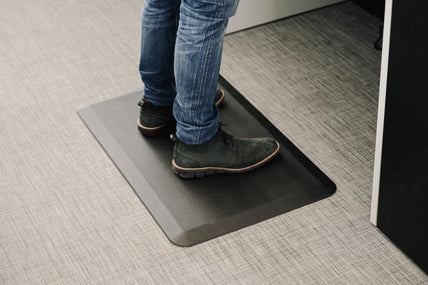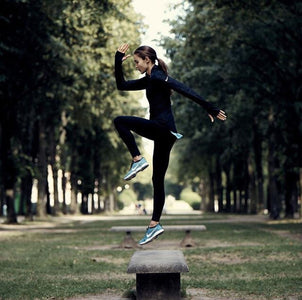About Us - The Movi Story
By Daniel Angelini on June 06, 2019INTRODUCTION
My Dad is a remarkably active and strong person who regularly goes to the gym, swims and boxes. He’s a finance professional and like many of us, spends an average of 10 - 12 hours a day sitting; at his desk, in meetings, driving, during meals, and as downtime in the evenings.
In 2011, at just 56 years old, he underwent spinal surgery due to acute lower back pain.The procedure was called ‘lumbar laminectomy’. It’s when there is a prolapsed intervertebral disc, meaning that the ‘padding’ between two discs in Dad’s lower spine had worn out; intervertebral discs act as shock absorbers in our spine. The surgeon needed to cut away some bone, bone spurs, and ligaments to allow for decompression.
My brother is also extremely fit, at 34 he’s continually putting me to shame. He trains 4 - 5 times a week doing a mix of cycling, running, swimming and weights, always with another triathlon or half ironman months away. He works with my Dad in finance, and therefore sits for over 8 hours everyday at work, plus he sits while driving, eating and relaxing at home. While he is athletic and fit, like my Dad he suffers from lower back pain.For two very fit guys who exercise constantly, the fact they both suffer from acute lowerback pain seems counterintuitive to the benefits you would expect from exercising so often.
Through research I will share later on in this book, it is very clear why they experience this pain.My painful experience wasn’t with my lower back, it was acute sciatica in my left leg.Acute sciatica is the pinching of a nerve that runs from your gluteal all the way down your leg, right down to the middle of your foot. I was 25, it was winter, and I wanted to step up my fitness. So I started running 2 - 3 times a week. After sitting all day at work, taking the train home, and with little to no warm up, I would run 10 kms at a decent pace. After 3 months, I began to feel a pinch down my left leg. It became too intense to run. I tried everything to treat it; physiotherapy, osteopathy, steam rooms, yoga and acupuncture.
The problem was that after sitting all day my muscles became disengaged, weak, so when I would jump into challenging physical exercise for 45 - 60 minutes at the end of the day it would aggravate the problem. Plus sitting all day long placed additional pressure on my spine, which was making things worse. It took almost 2 years to heal.
Over the past few years many health professionals and health institutes have compared sitting for 12 hours a day to smoking. Your risk level of being diagnosed with heart disease and cancer are comparable if you’re a chronic sitter or a chronic smoker. Thus if you have a job where
you’re sitting for 8 hours a day 5 days a week, plus all the additional sitting time outside of work, you’re doing a comparable amount of damage to your body as smoking. It’s a scary discovery, but also odd that it’s taken us so long to realise. Sedentary behaviour is causing a health epidemic - and we must start talking about it.

MY INTEREST IN HEALTH
I’ve had an interest in health since I was 15. I had a bad snowboarding accident that tore ligaments in my left knee, leaving me virtually unable to walk. Some of my friends had experienced similar injuries and had taken the traditional approach of surgery. They were on crutches for several months and unable to play sport for almost a year. That didn’t sound like fun to me, so I explored an alternative approach with acupuncture. I still remember it clear as day...
The doctor put 18 acupuncture needles into my left knee and surrounding ligaments, then attached the end of each acupuncture needle with a thin cable that connected to a machine which would shake every 20 seconds, sending a tremor through the acupuncture needles. It was probably the most painful 20 minutes of my life. But miraculously at the end of the treatment I was pretty much walking out of his clinic. He gave me some strengthening exercises to do for the next two weeks, after which I was fully recovered. It fascinated me that this worked so much more efficiently and effectively than surgery, and is where my interest in health kicked off.
Fast forward to when I was 27 and being admitted into hospital due to extreme stomach pain with no obvious cause. I was in a great deal of pain that even after taking high-gradepainkillers it was unbearable. I was in hospital that night, my wife-to-be beside me, gazing at the blank ceiling and constantly repeating to myself, “I never want to end up in here again”.
Lying on that hospital bed shocked me into fully grasping that if I didn’t have my health, I didn’t have anything. My passion for preventative health intensified there and then.

I’M RESEARCH OBSESSED
I’ve always been one to research obsessively to build my own informed view on a myriad of different topics, whether they be in health, tech or household items. I’m the kind of guy who, upon first hearing that something is really good for you, spends a ridiculous amount of time researching it to find out for myself.So naturally, when my dad, brother and I all experienced unexpected physical health issues, my research into the root cause began.
FACTS I DISCOVERED WHEN I STARTED RESEARCHING
1. Many office workers spend 11+ hours a day sitting (1), which significantly increases their risk of heart disease, diabetes, obesity and cancer. Some studies have suggested that prolonged physical inactivity can increase heart disease risk by as much as 147% (2).
2. Physical inactivity is the 4th leading risk factor of death globally. 6% of deaths globally result from physical inactivity (3). This is more than lung cancer and HIV combined. These are preventable deaths and it seems like very few people are taking it seriously.
3. 1 in 6 people have suffered lower back pain in their life (4) and sitting puts 40% more pressure on your spine than standing (5). Chronic lower back pain is becoming more prevalent from the age of 20+ years onwards and is costing the world billions.
4. Exercise and movement are vital for good health as they significantly reduce our risk of cancer, heart disease, diabetes and obesity. One study proved that regular exercise can reduce cancer risk by as much as 50% (6).
![]() BUILDING MY FIRST STANDING DESK
BUILDING MY FIRST STANDING DESK
While researching in 2013 I came across a Lifehacker article (7), which is still popular today.It explains how to use cheap IKEA products to construct a desk add-on that would allow you to standup while you work. I immediately rushed to IKEA to test it out: I used a square side table (the ‘Lack’), two plastic brackets, and a shelf. Altogether the cost was $40. I measured my arms at a right angle,my height, and the base desk height and assembled my DIY stand-up desk platform. I began using it at home as I didn’t yet have the courage to bring it into the office for fear of judgement. It was a DIY desk
made on a budget after all.
Like most things that are DIY on a budget, it had its downfalls. My desk add-on was really bulky,wasn’t adjustable, wasn’t ergonomic, and didn’t have a great deal of space for me to have notes and papers around me while I worked. Most annoying was that every time I wanted to sit down I would have to disconnect everything, find a spare desk space and work off my laptop screen rather than my large external monitor. Despite all of this I was proud of my creation, it was good enough to get me started.
A few months later I landed a job with Uber HQ in Australia. Being such an innovative and fast-growing startup I thought to myself, “if I’m ever going to bring something different into work then surely a San Francisco tech startup would be the place”. So on my third day, I brought in my bright orange IKEA DIY standing desk. I was a bit nervous, being the ‘new guy’ particularly when you do something outside the norm but I was intrigued to see what they would think of my health hack. Most of the team took an initial interest, asking a few questions, but that was it. However, over the next few months of watching me use it, many started constructing their own. They used boxes, crates, or any type of object that would create two platforms of distinct height on their existing desk; one platform for the keyboard and one platform for the monitor. Later that year when I visited Uber HQ in San Francisco, I saw they were also experimenting with
standing desks, which confirmed that this was becoming a ‘real thing’.
Six months created enough interest across the team to consider buying some ‘real’ standing desk attachments (a product that goes onto an existing desk that allows you to sit and stand while you work).
We were moving into a new office and decided to go ahead with the purchase. And by the end of the following year, every Uber office in Australia had standing desks!










